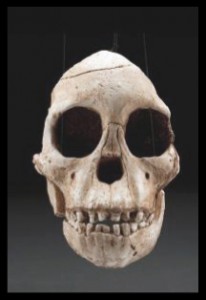Smithsonian Evolution Storytelling
 New high-resolution CT scans of the Taung Child skull (pictured left) by an international research team led by Ralph L. Holloway of Columbia University in New York raise renewed questions about the institute’s inane Smithsonian evolution storytelling practices.
New high-resolution CT scans of the Taung Child skull (pictured left) by an international research team led by Ralph L. Holloway of Columbia University in New York raise renewed questions about the institute’s inane Smithsonian evolution storytelling practices.
Discovered in 1924 in South Africa, models of the skull have been duplicated for natural history museums worldwide, including the Smithsonian, as evidence of human evolution. Found near Taung, South Africa, the lynchpin skull was tagged with the common name of Taung Child because of the fossil’s estimated age of 3 years. It was later named Australopithecus africanus, meaning the “southern ape from Africa.” However, Hollow’s new high-resolution CT scan images undermine the long-held pre-Homo fossil status of the skull.

